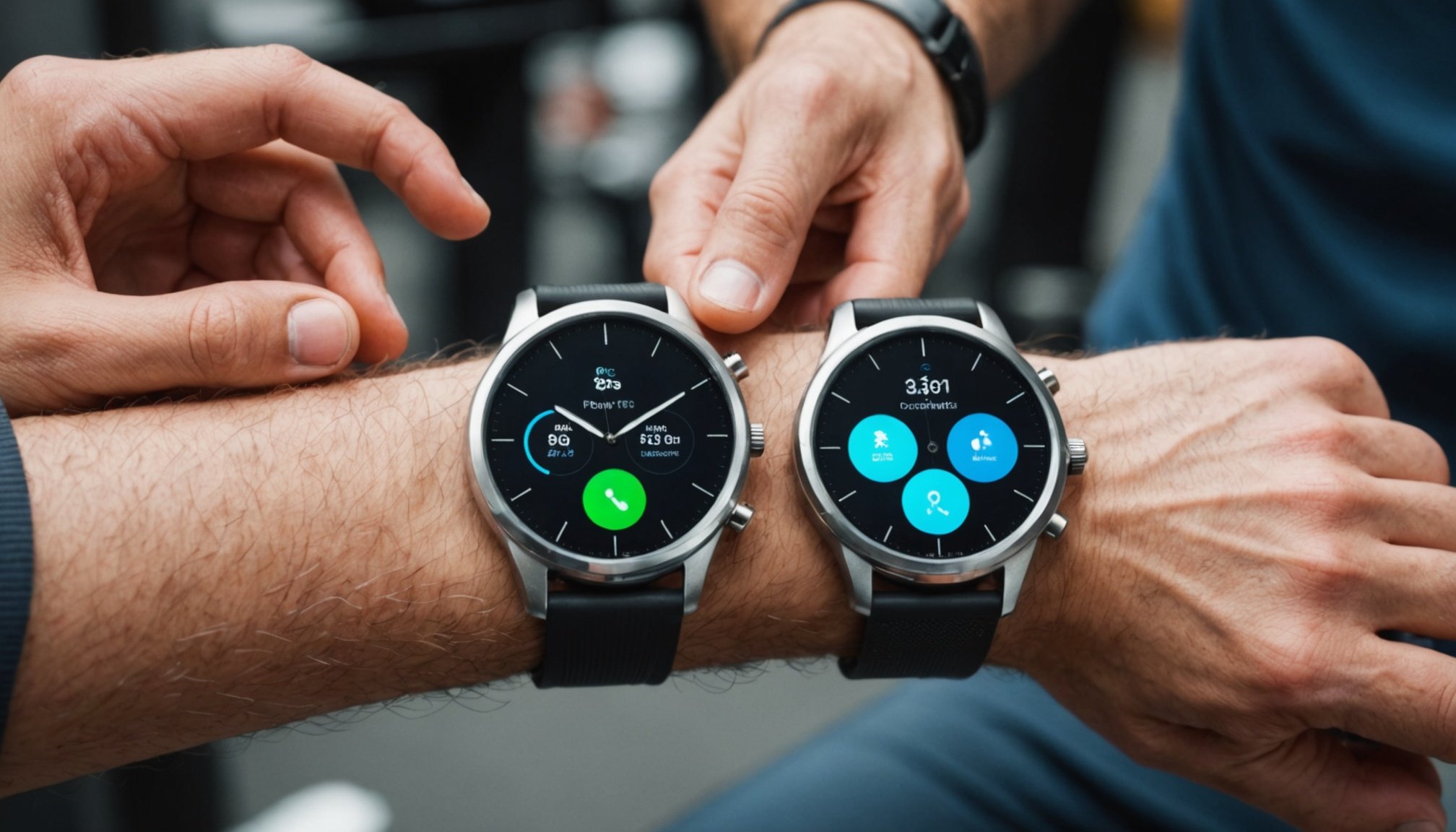Overview of Smartwatch Technology in Fitness Monitoring
Smartwatch technology has rapidly evolved, transforming how we monitor health and fitness. These innovative fitness tracking devices have grown from simple step counters to sophisticated tools measuring a variety of health metrics. With each advancement, wearables enhance our understanding of personal wellness.
Modern smartwatches now offer an array of features to improve fitness tracking accuracy. They utilise GPS for precise distance measurement, heart rate monitors for continuous pulse tracking, and even SpO2 sensors to gauge oxygen levels. These functionalities are critical in providing reliable feedback on an individual’s physical activity and health status.
However, it’s important to distinguish between fitness bands and smartwatches. Fitness bands focus primarily on basic health metrics like steps and sleep, catering to users seeking straightforward functionality. In contrast, smartwatches integrate broader capabilities such as app support and communications, alongside in-depth fitness monitoring. This multifunctionality enhances their appeal as comprehensive health companions.
The ongoing innovation in wearables reflects industry trends towards personalized health insights, making smartwatches pivotal in health-conscious lifestyles. This evolution indicates an increasing reliance on wearable technology to support daily health and fitness goals, offering a compelling glimpse into the future of personal health management.
Overview of Smartwatch Technology in Fitness Monitoring
In recent years, the evolution of smartwatch technology has been remarkable, bringing advanced capabilities to health monitoring. At the heart of these fitness tracking devices are biometric sensors that serve crucial roles in accurate measurement. These sensors enable precise tracking of various health metrics, such as heart rate and sleep patterns, offering valuable insights into users’ well-being.
In addition to the hardware, data analytics plays a significant role in enhancing the accuracy of fitness metrics. By processing data collected from sensors, smartwatches can present users with more reliable information, which supports informed decision-making. As a result, users can better tailor their workouts to meet personal fitness goals.
Furthermore, sophisticated algorithms also contribute to superior performance tracking. They sift through data to identify patterns that might indicate a need for lifestyle changes. These algorithms also help in personalising feedback based on the user’s activity profile, encouraging healthier habits.
Overall, the marriage of biometric sensors, data analytics, and innovative algorithms exemplifies the cutting-edge techniques employed to enhance fitness tracking. With continuous innovations, smartwatches are positioned to become indispensable tools in personal fitness and health management.
Comparison of Leading Smartwatch Models
Diving into smartwatch comparison, several leading models distinguish themselves in fitness monitoring features and model reliability. Let’s examine three notable contenders to help guide your decision-making process.
Model A: Features and Accuracy
Model A is renowned for its precise fitness monitoring features, boasting advanced biometric sensors. Users appreciate its exceptional heart rate monitoring and sleep analytics. Expert ratings commend Model A for its impressive accuracy and reliable performance, even in diverse conditions.
Model B: Features and Accuracy
In contrast, Model B excels in innovative data analytics, offering a unique algorithm specifically for endurance sports. It’s a favourite among athletes for its tailored fitness monitoring features. Users have reported consistently reliable results, with minor discrepancies during high-intensity activities.
Model C: Features and Accuracy
Finally, Model C stands out for its all-around performance. It integrates a comprehensive suite of fitness monitoring features, including SpO2 sensors and GPS tracking. User reviews highlight its solid accuracy, although some note challenges with syncing data across devices.
In summary, navigating the world of smartwatches involves weighing various fitness monitoring features and reliability standards. Each model offers distinct advantages, ensuring a broad spectrum of choices to align with diverse fitness needs and preferences.
Case Studies on Accuracy Improvements
In examining accuracy case studies related to smartwatches, several real-world applications showcase their evolution and improvements. One prominent case involves a leading manufacturer enhancing its fitness tracking devices through iterative software updates, significantly boosting heart rate monitoring precision. These developments have been documented by users, highlighting genuine improvements in daily workouts and overall health tracking reliability.
Biometric sensors play a pivotal role in these advancements, offering more precise data collection. Users reported issues with heart rate readings during high-intensity workouts, often attributed to sensor positioning and movement. Manufacturers addressed these accuracy challenges by modifying hardware designs, demonstrating commitment through ongoing product enhancement.
User experiences with smartwatches also illustrate improvements in data accuracy. One individual mentioned the device’s initial discrepancies in activity recognition, which were resolved through machine learning updates. Such adaptability showcases the potential of wearable technology to fine-tune its performance, responding effectively to user feedback.
Incorporating feedback from health professionals further enriches the body of research on smartwatch accuracy. Their endorsement of wearable benefits, such as personalized health tracking, underscores the pivotal role these devices play in preventive health care, continuing to shape the landscape of modern fitness monitoring.
Expert Opinions on Fitness Monitoring Tech
Gaining insights from expert insights within the smartwatch industry can illuminate future trends and industry standards in technology predictions. Leading professionals anticipate a surge in AI and machine learning’s role, facilitating more nuanced data interpretation and personalised fitness recommendations, marking a significant shift in technology predictions.
Industry standards for smartwatch accuracy set by these experts serve as benchmarks, ensuring consistency in how devices perform across different contexts. These standards are vital for mutual understanding, allowing users to make choices based on expected performance levels and safeguard satisfaction. Experts often highlight the need for these standards to evolve alongside technology, aligning precision with innovation.
Predictions for future advancements underscore an increased emphasis on biometric sensors, which continue to be pivotal in tracking health metrics reliably. Their evolution might expand functionalities, potentially offering new health insights previously unattainable through wearables.
Furthermore, the integration of smartwatch data into broader health systems could redefine user interactions with healthcare. By participating in this ecosystem, users are equipped to make health-conscious decisions, with technological evolution acting as a catalyst. This blend of insights and standards explains the growing trust and reliance on wearables within fitness monitoring.
Practical Tips for Enhancing Fitness Monitoring
For users seeking to maximise the advantages of fitness tracking devices, a few practical tips can greatly enhance monitoring accuracy and results. Ensuring correct biometric sensor placement is crucial. When sensors like heart rate monitors aren’t properly aligned, data reliability can suffer. Secure placement on the wrist ensures optimal contact and readings.
Adopting optimal usage strategies is advised for integrating smartwatch data into workout routines. Regularly update your device software to improve data analytics and leverage the latest algorithm enhancements. This ensures the most accurate insights and maximises the device’s potential.
Users should also differentiate between activity levels. Setting activity-specific modes, such as running or cycling, allows smartwatches to fine-tune metrics for each exercise type, improving load accuracy and feedback precision.
Avoid common pitfalls to further streamline your fitness monitoring experience. For instance, syncing data promptly prevents backlog and ensures current information reflects accurately. Pay attention to battery life; a device running low may display reduced performance or fail to record activities accurately.
These fitness tracking tips empower users to fully harness their smartwatches, enhancing personal health management through informed, data-driven decisions.
Potential Health Benefits of Enhanced Monitoring
Delving into the health benefits of advanced wearable technology, it’s clear that accurate fitness monitoring can significantly enhance overall well-being. Smartwatch health monitoring not only supports traditional fitness activities but also fosters personalized health insights, essential for preventative health care.
The advantages of wearable technology are manifold. Smartwatches enable users to track vital signs and fitness metrics in real-time, offering insights that inform lifestyle choices and health management. For instance, by continuously monitoring heart rate and sleep patterns, users can identify trends and make adjustments before issues escalate.
Improved fitness tracking accuracy leads to better health outcomes. Accurate data analysis can guide users in making informed decisions about exercise and rest, potentially reducing risks associated with overexertion or stress. Moreover, the ability to share this data with healthcare professionals can enhance diagnostic accuracy and tailor treatment plans.
Smartwatches thus play a pivotal role in preventive health care by empowering users to recognize early warning signs of health issues. This encourages proactive health management, making wearables indispensable in contemporary health routines, and facilitating a more informed, health-conscious lifestyle.
Future Trends in Fitness Monitoring with Smartwatches
As fitness monitoring technology advances, exciting developments are anticipated in the smartwatch industry. Emerging innovations in technology are poised to revolutionize how users interact with these devices.
The integration of AI and machine learning is expected to enhance fitness monitoring capabilities. These technologies can interpret complex data patterns, leading to more actionable insights for users. As a result, smartwatches will become even more proficient at offering personalized health advice.
The evolving landscape of fitness wearables is also set to expand through increased functionality. Future smartwatches may incorporate more comprehensive health metrics, possibly including metrics not currently available, like hydration levels or even blood pressure monitoring. This enhanced scope promises to further align smartwatches with holistic health management objectives.
Continued technology evolution suggests that user engagement will grow, with smartwatches playing a more prominent role in daily fitness routines and broader health systems. As smartwatches become pivotal in a health-conscious ecosystem, the market is predicted to see significant growth, driven by demand for the next generation of smartwear technology.
These future trends reflect both the potential and challenges of continually pushing the boundaries in an ever-evolving technological landscape, offering users unparalleled insights into their health and fitness.


